
Written by Frank L. Holt

 the obelisk of Seti I and of his son Ramses II, was born around 1291 BC and raised a devoted Egyptian in spite of my current address. At birth, I weighed more than 250 tons and measured more than 78 feet in length. It took an army of chanting men with chisels and heavy hammers to labor me out of ancient Egypt’s granite quarries. For months, workers swarmed over me, as the parent rock was cut away, and I was delivered, cut by cut, blow by blow. Great levers then lifted me to an embankment, where thousands pulled at straining ropes, dragging me, gently despite my great bulk, to the Nile River. There, cradled in a special barge, I journeyed down river to Holy Anu, City of the Sun.
the obelisk of Seti I and of his son Ramses II, was born around 1291 BC and raised a devoted Egyptian in spite of my current address. At birth, I weighed more than 250 tons and measured more than 78 feet in length. It took an army of chanting men with chisels and heavy hammers to labor me out of ancient Egypt’s granite quarries. For months, workers swarmed over me, as the parent rock was cut away, and I was delivered, cut by cut, blow by blow. Great levers then lifted me to an embankment, where thousands pulled at straining ropes, dragging me, gently despite my great bulk, to the Nile River. There, cradled in a special barge, I journeyed down river to Holy Anu, City of the Sun.
The pharaoh Seti saw me as a monumental shaft of the sun’s pure light that would stand before the temple of the sun god Ra. But before his wish was accomplished, fate intervened: Seti passed to the world of the dead.
I lay heartbroken and half-born until Seti’s son, Ramses II, took his place as ruler of Egypt in 1279 BC Like a second father, Ramses set me towering over the sun-priests at Anu. In the hush that fell as I found my footing, everything finally made sense to me. I saw the world as it was intended to be—not flat and near, but far below, stretching out in every direction with vistas of beauty and mystery. I recognized nearby my brother obelisks, some already a thousand years older than I. Across the Nile, I glimpsed the pyramids that alone made me feel small among the monuments of men. On my polished sides, the priests pointed out the deep-cut symbols that expressed the pride and faith of my two fathers, Seti and Ramses. The Greeks, who came here often, gave to these signs the popular name “hieroglyphs,” which translates into English as “priestly carvings.” They also coined a playful word for my siblings and me—obeliskos, meaning “a little meat skewer.”
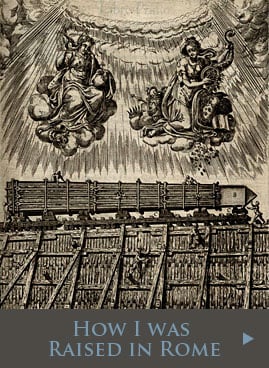 Yet, neither of my fathers could have foreseen the troubles that awaited me. When I was 775 years old, I watched in horror the day that King Cambyses of Persia made my home a ruin. The temples of Anu burned, and the priests perished. Some of my sibling obelisks toppled to the ground, where they lay like sunbeams lost in shadow and dust.
Yet, neither of my fathers could have foreseen the troubles that awaited me. When I was 775 years old, I watched in horror the day that King Cambyses of Persia made my home a ruin. The temples of Anu burned, and the priests perished. Some of my sibling obelisks toppled to the ground, where they lay like sunbeams lost in shadow and dust.
Some 200 years later, a young Greek from Macedonia, Alexander the Great, freed Egypt from Persian rule. I glimpsed the extraordinary man myself when he marched through Anu, which now was called Heliopolis, Greek for “Sun City.” When Alexander died, his ambitious general Ptolemy became our pharaoh. His dynasty endured until one of the worst days of my life, for when Cleopatra, the last of the Ptolemies, departed from Egypt, so did I.
Cleopatra’s blood was Greek, but the heart that pumped it was surely Egyptian. She loved this land, knew its history, and spoke its language. But a little Latin-speaking nation far to the west had grown powerful, and its legions were gobbling up most of the Mediterranean world. Cleopatra did all she could to spare us the worst. Her charm and cunning captivated the Roman leader Julius Caesar, but not his successor, Octavian. I was almost 1,300 years old on the day Octavian and his Romans added Egypt to their empire. If stone could weep, I would have flooded the Nile that day.
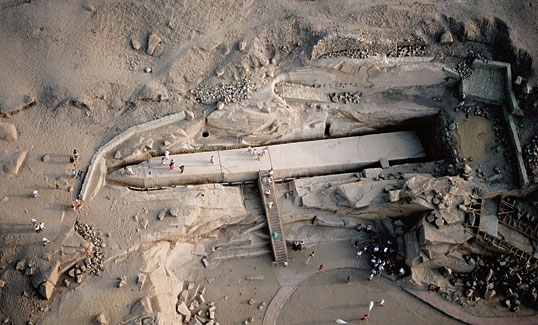 |
| YANN ARTHUS-BERTRAND / CORBIS |
| Four times my weight and almost
twice my height, the largest obelisk ever quarried in Egypt lies stillborn at Aswan, fatally cracked. |
In the wide eyes of the Romans, I saw greed as they stared up at me, calculating my height, my weight, and my age as they would a prospective slave. I was chosen as the first of Egypt’s many obelisks to be hauled away to Rome. Once again I was laid flat, and the river waters bore my weight to the Mediterranean and then across its waters to Italy. I sailed up the tiny Tiber River to Rome as a trophy of war. I am a captive still to this day.
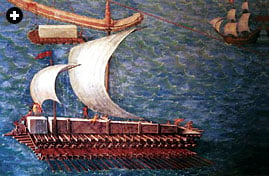 |
| CARLITOS GUILLERMO LUNGHI / EGIPTO.COM |
| A Roman ship, above, carried me off like so many others from Anu (Heliopolis), where but one survivor remains, below, now surrounded by a suburb of Cairo. |
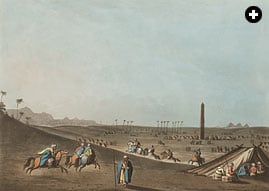 |
| LUIGI MAYER (1802) |
Octavian, who took the honorary title of Augustus and established himself as the first emperor of Rome, had me hauled to the city’s racetrack, the Circus Maximus. There I was raised on the spina, the long barrier down the middle of the track. The Romans could not read my hieroglyphs, but they busied themselves between races by mouthing the self-praise Augustus had had inscribed in Latin on two sides of my base. My popularity with the Romans set a trend that eventually brought many of my brothers to Rome and then to cities around the world. Today, only one still stands in Heliopolis.
In the years that followed, people came from every province of the empire to admire me. Soon, no monument matched my fame—not even the pyramids I had envied so much in my youth. Yet, my new home puzzled me, as I watched 150,000 toga-clad sports fans cheering the chariots revolving around me, hoping for spectacular crashes at the turns. They also cheered at horse races, boxing competitions, and holiday spectacles.
When I approached the age of 1,160 years, something remarkable occurred in the Circus. Constantine II, a member of one of ancient Rome’s last ruling families, brought to me a distinguished visitor from my fatherland. Older and taller than I, the obelisk of the pharaohs Thutmose III and his grandson Thutmose IV joined me on the spina. But soon, the empire that had stolen us weakened, stumbled, and fell. Soon, too, one of us fell, when some men attacked my brother and toppled him. Alone among the ruins, I thought again of Anu and could not bear the sorrow. On a day I no longer remember, I, too, reeled and thundered onto the ground. Earth and grass slowly smothered me, until the warmth of Ra was gone. Ashamed and shivering, shattered in three pieces, I could only dream of Egypt.
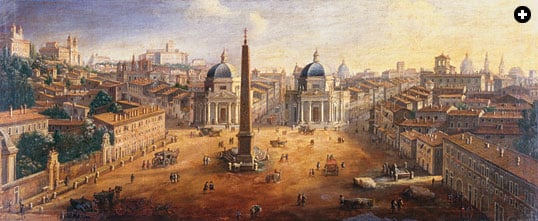 |
| GASPAR VAN WITTEL / CHRISTIES IMAGES / CORBIS |
| For the last half millennium, Piazza del Popolo has been my home. In the early 18th century, a Dutchman painted my portrait, showing behind me the Via Corso that leads to the old forum and the Circus Maximus. |
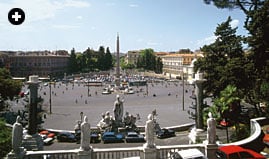 |
| GUENTER ROSSENBACH / ZEFA / CORBIS |
| Today, I am dizzied by all the motorized chariots but cheered by the people who gaze up at me andI believe it is
a new gesture of respectraise a little box to their eye, wink at me, and pass on. |
Nothing disturbed my dreams and solitude until I was nearly 2,800 years old. At that time, some people in Rome who knew I had once towered nearby used long iron probes to search for me. Their success resulted in a visit from the head of the Catholic Church, Pope Sixtus V. Like Octavian, he saw me as a perfect public monument. My pieces were strapped onto heavy sledges and pulled through the city’s streets until we reached the place they called the Piazza del Populo, “Square of the People”—my home for the last 500 years. For a while, I served as a starting post for horse races, as well as the setting for public executions. Worse, though, are the motorized chariots that race around me now for no prizes whatever except a parking space.
So, like a pendulum of history itself, I, the obelisk of Seti I and his son Ramses II, have risen and fallen through the millennia. Today, I wait for the next change, for surely someday I will signal another age yet unimagined.
click here to view the original article
 |
Frank L. Holt ([email protected]) is a professor of history at the University of Houston and most recently author of Into the Land of Bones: Alexander the Great in Afghanistan (2005) and Alexander the Great and the Mystery of the Elephant Medallions (2003), both published by the University of California Press. |





